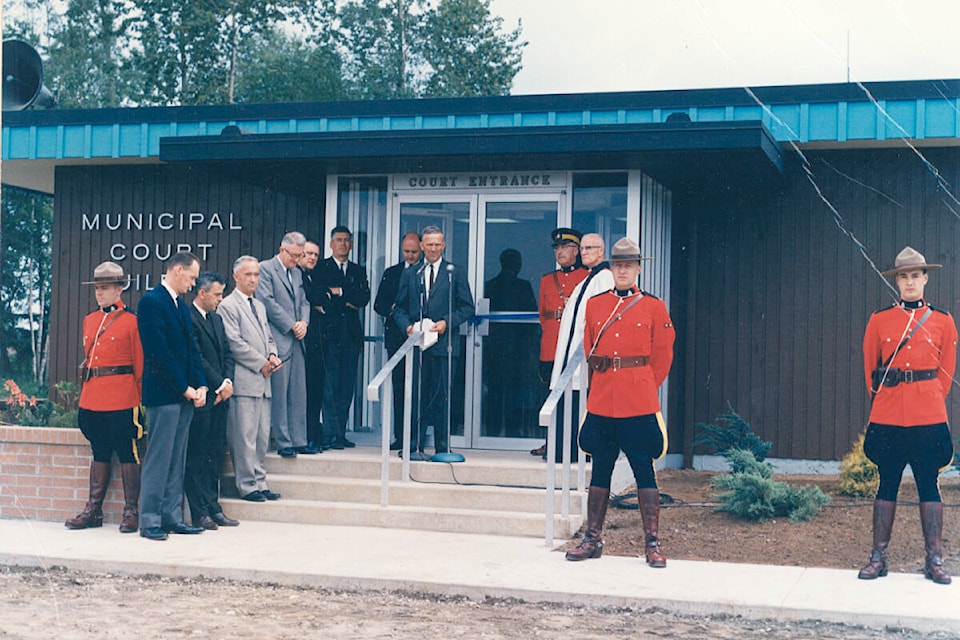The history of the RCMP in Langley began in 1950, when the community had a tiny force of officers.
In August of that year, the provincial government put a momentous decision into practice. They shut down the British Columbia Provincial Police, which had existed since 1858, when B.C. was still a colony of Great Britain, and transferred the vast majority of its members into the RCMP.
That included Langley, but there weren’t too many officers here to trade in their provincial police uniforms for RCMP serge.
According to a January 1950 article in the Langley Advance, policing costs that year were going up.
Langley was expected to spend $11,044.07 on its policing contract for the year, with higher uniform, mileage, and cost-of-living expenses driving the increase.
That money “covers the cost of two and a half men in this district plus the cost of operating one car and a motorcycle,” the newspaper reported.
The officers were working hard – according to an inspector with the provincial police, Langley’s officers were “putting in 70 hours a week per man, plus court time.”
The transition from the provincial police to an RCMP contract was controversial at the time. But by the mid-1950s, the RCMP were thoroughly embedded in Langley. Articles in the Advance indicate they were sponsoring a peewee bowling league, and meeting with the Farmers Institute to tell locals how they could help carry out their work.
They were also busy rounding up suspects related to local thefts.
In March of 1953, a suspicious merchant and some local Mounties caught a group of safe-crackers. The merchant approached the police when he received a singled $10 bill, and the officers traced the cash back to a blown-up grocery store safe in Vancouver the previous night, arresting four suspects.
On Jan. 20, 1955, the Advance reported that three constables – R. Zaruski, J. Brown, and J. Kanik – busted up a burglary ring and arrested three suspects between 18 and 20 years old. The local Mounties were aided by a canine member from the local detachment, a tracking dog named Silver.
The recovered loot included TV sets, radios, adding machines, power tools, clothes, and 40 cases of raspberries stolen from Yarrow.
When the RCMP first took over policing in Langley, the community was largely rural. In 1951, there were just 12,267 people counted in the Canadian Census for the whole community.
The population began booming in the 1960s, ’70s, and ’80s as suburbs sprung up. The RCMP expanded in turn, but it by the 1980s, it was having serious trouble keeping up with the need for new facilities.
In the 1960s, the RCMP may have worked out of a then-new municipal court building for a time. Then also worked out of the City and Township offices. But the force quickly outgrew its shared facilities.
For a time in the late 1980s and early 1990s, the RCMP headquarters in Langley was in a cluster of portable buildings near the corner of 224th Street and Fraser Highway, recollected Township Councillor Steve Ferguson.
Ferguson recalled how the then-mayor of the Township John Beales, and John Scholtens, a councillor who would serve as mayor after Beales, pushed for the construction of a brand new headquarters. Ferguson was a rookie councillor at the time.
The portables were not a great place for the Mounties, Ferguson recalled.
“It was really, really a disaster.”
There were the usual wrangles over where to place the new facility between Langley City and Township, which shared responsibility for policing, before the site on 224th Street – near what was then Township hall – was chosen.
Built in the 1990s, the red-brick detachment headquarters is the building still used by RCMP officers today. However, the detachment has almost doubled in size during the last 20 years, and now has about 210 officers, not to mention civilian support staff.
Not long after that new building opened, Sgt. Michelle Stewart started working there, first as a civilian dispatcher, and from 2000 on as an RCMP officer.
Stewart has worked in multiple units, starting as a general-duty officer, community policing, bike patrol, fraud investigation, as a domestic violence program coordinator, as a serious crime investigator, the NCO of general investigations, and is now in administration at the detachment.
She’s seen a lot of changes in the past 23 years.
One of the big ones has been the switch to regional integrated units.
Before 2004, Langley RCMP investigated its own homicides. IHIT had yet to be formed.
“We were a small detachment, if we had a homicide, it was all hands on deck,” Stewart recalled.
Langley RCMP also had its own forensic identification unit and dog officers, both of which have also become parts of regional integrated units, bringing together specialists from across the Lower Mainland.
Cell service was also spotty in the rural corners of the Township, Stewart recounted. If officers were on patrol around 272nd Street and Zero Avenue, they had no radio signal and no access to the computer in their cars.
There were also a lot fewer security cameras. Now police have access to footage from stores, homes, and dashcams for many cases, including missing persons.
The big change is the huge growth in Langley’s population. When she started in Aldergrove, Stewart said she got to know many of the neighbourhood kids, and also who the local troublemakers were.
“It felt much more small-townish,” she said.
Have a story tip? Email: matthew.claxton@langleyadvancetimes.com
Like us on Facebook and follow us on Twitter.
